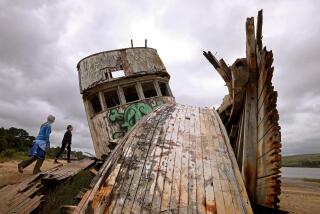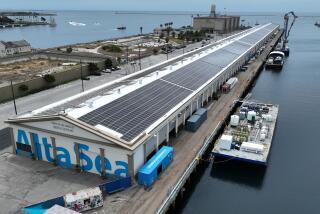Friends in foul waters
For the self-proclaimed “escapees from society” who live there, Leeward Bay Marina is a perfect hideaway: a nest of mostly old boats bobbing over a toxic hot spot in the nation’s busiest harbor complex.
Hidden by a hectic maze of trains and cranes, big rigs and refineries, the marina offers solitude, as well as shelter, to dozens of “live-aboards” who make their homes above the fouled waters at the mouth of a flood control channel.
“Ah, Leeward Bay,” locals like to say with a laugh. “Where the sewer meets the sea.”
That joke pretty much sums up the dual nature of the Wilmington facility. It can be ugly but oddly beautiful, dogged by despair but buoyed by hope. The marina’s residents share a camaraderie. “Everybody knows everybody else’s business,” said resident Marc Greenwald. But sometimes they just want to be left alone.
Awash in bad debt, lost jobs and lost weekends, the residents -- retirees, disabled veterans, shut-ins, runaways, ex-cons, day workers and a few sex offenders -- have come to view Leeward Bay and its listing watering hole, the Chowder Barge, as their isle of dreams.
“Look around,” said 11-year marina resident Vernon Lovelace, who owns a scuffed-up little workboat named Indigent. “The only things holding up some of these boats are good luck and paint. But you can live pretty good here on $800 a month. It’s not a great life, but it’s comfortable. A lot of these people have no place else to go.”
At certain times of day, when looking in certain directions, Leeward Bay offers glimpses of a glassy dawn or radiant sunset streaming between swaying masts. There are endless days of mellow rocking, nights aglow with industrial lights and down-home gatherings at the Chowder Barge, where regulars carry on about funny boater mishaps and old times. Or the occasional tragedy. They talk about the man who fell into the water last year and drowned a few yards from his boat.
Not all the tenants are down on their luck. Some sail magnificent vessels, which they dock at Leeward Bay because of its relatively low monthly slip rates of about $10 per foot, well below the $15 charged elsewhere in the harbor. The marina is composed of boat slips jutting from shore, along with others attached to a nearby floating dock anchored in the Dominguez Channel. The facility has been in Robert Perel’s family for 50 years.
“I get the craziest of the crazies,” said Perel. “And I have a soft spot in my heart for them. I feel as comfortable here as I do at home on the Westside of Los Angeles.”
A mantra often heard at Leeward Bay goes something like this: One of these days, I’m going to fix my boat, untie and sail into the sunset.
In the meantime, the engine in Dedee Newman’s 42-foot boat can start, but it’s got a bad oil pan. Glenn Truitt’s 27-footer -- a sleek fiberglass craft built for speed -- can sail, but the engine doesn’t work. Sonja Massingill’s 36-foot cruiser needs an engine and a prop. Even a popular resident Mallard duck has a cracked beak.
Standing on the top deck of her boat, Toujours Mon Amour, and shouting to be heard over the horns of a freight train hauling scrap metal, Massingill spread her arms and welcomed a visitor to “paradise.”
“There’s nothing like sitting out here at night with a few drinks and enjoying the lights on the refineries and drawbridges,” she said. “It’s like a damn fairyland.”
The marina exists in isolation at the southern end of the narrow Dominguez Channel, at the intersection where the flood control channel’s tainted outfall mixes with salt water. It’s about four miles from the breakwater, and on a good day with smooth conditions, it takes an hour to sail from Leeward Bay to the open ocean, given the port-wide speed limit of 5 knots (a bit less than 6 mph).
Living full time on the water is legal, to a degree. In June 2001, the Port of Los Angeles renewed the 11 marina leases it controls in Wilmington, limiting the number of live-aboards to 5% of each marina’s berthing capacity and to no more than four residents per boat. Port officials say they might allow an informal limit of 10%, provided that marina owners upgrade their facilities to accommodate that many residents.
Those rules, however, do not apply to Leeward Bay Marina, which has operated for five decades under terms of a rare month-to-month master lease that does not include a limit for live-aboards, according to the marina’s bookkeeper. That might explain why about 30% of Leeward Bay’s 180 slips are leased by live-aboards. That’s about 75 residents.
Although many boats have peeling paint and rusty prows, Perel has invested heavily in secure pilings, new docks and well-maintained restroom and shower facilities. But the channel is one of the most polluted spots in the harbor area, with high levels of carcinogenic DDT and PCBs, which accumulate in the tissue of bottom-feeding fish.
A witch’s brew of debris, bacteria, pesticides and other toxic runoff flows into the marina whenever it rains, so locals try to avoid contact with the water. Locals have seen just about anything float by -- dead dogs, dead porcupines, even artificial human limbs.
A local mariner was only half kidding when she said: “We don’t get in the water or eat anything that comes out of it. Our fish have three eyes!”
Still, it’s home.
Glenn Truitt, a disabled Vietnam veteran with long gray hair tied in a ponytail, spent years in various wilderness hovels before nesting on a boat moored to the dock floating in the channel. Twice a day, he rows or motors a tiny skiff to shore to pick up mail, get some grub or catch up on gossip.
“It’s not exactly picturesque, but nobody bothers me and I don’t bother nobody,” he said. “But once I settle some claims with the veterans administration, I’ll have the money I need to get me another life, fix my boat, maybe go up and see my kids in Sacramento.”
But cab driver Alan West said he is content to continue “living like a hermit in a cave,” referring to the cramped cabin of his old 33-footer. Surveying his craft’s warped wood paneling, crooked Venetian blinds and decking splattered with heron droppings, he said, “It’s old, waterlogged, kind of a dump. Low end. But where else can you find a place to live for less than $500 a month?”
Greg Ashley, a maritime plumber and electrician who works in various marinas, has lived in Leeward Bay for two years and has a son who resides in an adjacent boat. Ashley’s roommate, a large green-wing macaw, is part of the Leeward Bay family. No one seems to mind when Ashley, after a long day at work, heads to the Chowder Barge for a beer with his bird. Ashley says he wouldn’t live anywhere else.
One resident who knows the cultural crosscurrents of Leeward Bay as well as anyone else is Lovelace, a bear of a man with a booming voice and white beard. Affectionately called “Tiny” by residents, he’s made ends meet over the last 11 years by towing boats and scavenging the harbor for recyclables.
Lovelace, 59, also lends a hand when his boss, Perel, needs help dealing with deadbeats, troublemakers and abandoned boats. In one craft left behind by its owner they discovered 35 boxes of costume jewelry, including 7,000 pairs of cheap earrings. Another boat contained what an office manager described as “the world’s biggest porn collection.”
One recent hazy morning, Lovelace tied his boat to the dock fronting the Chowder Barge, the marina’s cultural heart and soul, where a corn dog, a tasty slice of pumpkin pie and a cup of coffee go for $4.80. One resident swears he moved to the marina for the cooking there.
The restrooms are marked “Inboards” and “Outboards.”
Built in 1934 to serve the movie crew during the filming of “Mutiny on the Bounty,” the Chowder Barge lists to the side containing a walk-in cooler full of Leeward Bay staples, including ice, beer and wine. Over the years, it’s been a floating brothel, a houseboat, a machine shop, an art studio and an abandoned hulk.
It has been owned and operated since 1967 by Lyle and Mary Panter. Locals call her “Miss Mary,” an energetic waitress-cook-clerk-cashier with a hair-trigger temper.
Asked how long the barge has been listing, she said, “It leans like crazy! Hell, I don’t even want to know why. It’s been doing that for years.”
The regulars use humor to disarm her and get a read on her mood. Pouring coffee into the cup of a regular customer, she asked, “You want cream and sugar in that?”
“Just dip your little finger in it, Miss Mary,” he said. “That’ll sweeten it up.”
Panter just rolled her eyes and padded into the kitchen.
Barge regulars still talk about the time she accidentally drove her Chrysler over a berm and into the channel.
“This is gospel truth -- meaning if Jesus was standing right here I wouldn’t change a word,” Lovelace said, holding up his right hand for emphasis. “We busted the back windows and pulled her out. Then she handed me a sack of soaking wet $100 bills -- and a hair dryer to dry them out.”
No one can say how long Leeward Bay’s scruffy tenants and anti-establishment ambience can last as big shipping companies continue to gobble up waterfront property on which to stack their thousands of product containers.
This year L.A. and Long Beach authorities are pushing for stricter pollution standards and tougher code enforcement throughout the 52-square-mile harbor complex. Many marina residents fear such moves would prompt expensive upgrades that would translate into unaffordable slip fees. Stricter enforcement might pressure boaters whose vessels aren’t up to code to make repairs.
Port authorities, worried about the health and safety of Leeward Bay residents, also have a long-term master plan that calls for moving the marina a few hundred feet farther away from the trains and most polluted portions of channel.
John M. Holmes, deputy executive director of operations at the Port of Los Angeles, said any change probably would be gradual. “I don’t want to charge in like gangbusters and say, ‘You’re not in compliance. Get out,’ ” he said.
“Marinas will have to meet higher standards,” Holmes added. “But this is not a problem we are going to solve overnight.”
Still, that kind of talk worries Leeward Bay’s registered live-aboards and untold numbers of sneak-a-boards.
But Donna Ethington, a member of various port committees, aims to ensure that Leeward Bay and other marinas in the area are treated fairly. She’s resided in various local marinas for 27 years.
As the sun was sinking behind a pair of nearby dredging barges and the silhouettes of masts, Ethington, also Leeward Bay Marina’s bookkeeper, sighed. “The authorities don’t understand us,” she said, “but we’re port tenants too.”
The need for a place like Leeward Bay will always be there, even if the space isn’t.
“A few days ago, a young guy showed up with a guitar, bedding, a dog, and cash in his pocket saying he wanted to buy a boat and move in immediately,” Ethington said. “He bought a boat and took over a slip lease from an existing tenant.
“Trouble is, we don’t have room for another live-aboard. So we gave him 30 days to find another place to live.”
*
More to Read
Sign up for The Wild
We’ll help you find the best places to hike, bike and run, as well as the perfect silent spots for meditation and yoga.
You may occasionally receive promotional content from the Los Angeles Times.







